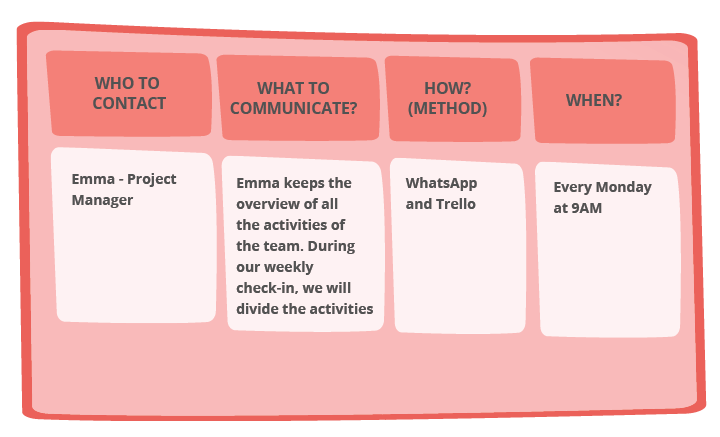Chapter 3: Planning the Project
The planning process includes the following actions:
- Break down the work into activities
- Determine the order of priority of activities
- Estimate the time needed per activity
- Assign roles and responsibilities

Planning when and how to monitor and control the project
This process of review and revision is part of monitoring and controlling the project. Monitoring and controlling will be easier to do with ongoing team check-ins.
For example; we meet every Monday morning to check-in on our current ongoing activities.”


Building a Project Schedule
To create a schedule we are following these steps.
- Identifying milestones: Milestones are the critical points in a project’s timeline that can be monitored to determine if the project is on schedule. They show completion of major pieces of the project.
- Defining activities: What activities need to be accomplished to meet each milestone?
- Listing activities: Activities are the “to-do” list for each activity.We are breaking down the project milestones and activities through a work breakdown structure (WBS).
- Determining the sequence: When will each milestone, activity and task be accomplished? To determine the sequence, we will need to assess which activities are dependent and which are independent.
A dependent activity means that another activity or task must be complete before the dependent activity can begin. Example: If I’m going to deliver the groceries, I have to buy the groceries first. So delivering the groceries is dependent on the shopping of groceries being completed.
An independent activity means the activity can be completed at any time and is not related to some other activity being completed. - Estimating the time: How long will each task take to be completed? This is your best guess based on past experience, considering the amount of work to be done. Underestimating the amount of time needed to complete each activity is a common error. Building extra time into the schedule can help ensure you have the time needed to complete your project on time.
- Building the schedule: With all of the above information in hand, it is now possible to build the schedule.

Activity 7: Work Breakdown Structure
With help from the text below, fill in the canvas:
Project management can be broken down into five consecutive processes:
- The Initiating process is the beginning of the project. During this process, project stakeholders are identified and a project manager is selected. Project goals and objectives are defined and authorization is obtained to proceed with the project.
- During the Planning process, the project plan is created. The project manager and team members define the activities needed to complete the final product, service or result. They also determine what staff and resources are needed, establish the timeline and available budget for the project. The planning process is very important to the overall success of the project. Without careful planning, a project manager and project team may find it very difficult to achieve project success.
- Executing is the process of working through the project plan. The executing stage involves performing the activities outlined during the planning process.
- Monitoring and Controlling occurs throughout the entire project. Monitoring and controlling involves ensuring that all the activities in the project plan are completed on time and within budget, as well as addressing any changes necessary to successfully achieve the project goals.
In the Closing process, project goals are delivered. Final administrative work is completed and lessons learned are captured to improve future projects. The closing process involves taking the time to celebrate the team’s successes along the way toward completion of the project.


Assigning Roles & Responsibilities
Sal: “For our team it’s important to understand the strengths, skills, and abilities of each of our team members to make sure they get the right responsibilities that fits their personalities and skill sets.
A Responsibility Assignment Matrix (RAM) can be used to assign team members to appropriate activities. Good practice is to also assign a backup person in case the primary person is unavailable.”

Planning when, what and how you will communicate
Emma: “Our team members and stakeholders (such as the school board, local store and the elderly home) need information on how the project is developing and what may need to change to get all of the work done.
Planning for communication involves having a clear understanding of who needs to communicate with whom and how often, as well as what information would be relevant and useful to each stakeholder. Check out the overview of this here:”


Activity 8: Planning for Risk
Identifying potential risks provides the opportunity to plan a response for both failure and success in advance that will help to avoid or minimize a negative impact on the project.
Risks could impact one or more areas of the project, including:
- Resources: Ability to acquire people, equipment, funding, or other resources to complete project
- Timing: Will deliverables or the entire project be completed on schedule?
- Scope: Completing and delivering all the items named in the original scope
- Quality: How well each deliverable meets the goals set in the acceptance criteria.
Fill in the risk level by dragging the first letter of the word into the right column:”

Go to the next Chapter
Key terminology
Click on the words to expand the window and understand what they mean:
Acceptance criteria:
Activity:
Assumption:
Closing process:
Communication management:
A component of the project, program, or portfolio management plan that describes how, when, and by whom information about the project will be administered and disseminated.
Constraint:
Deliverable:
Executing process:
Initiating process:
Lessons learned:
Milestone:
Milestone planning:
Monitoring and controlling process:
Planning process:
Project:
Project Charter:
Project Management
Project Manager
Project Schedule
An output of a schedule model that presents linked activities with planned dates, durations, milestones, and resources.
Project Team
A set of individuals who support the project manager in performing the work of the project to achieve its objectives.
Scope:
Scope creep:
Sponsor:
Stakeholder:
Stakeholder register
Resource
A team member or any physical item needed to complete the project.
Risk:
An uncertain event or condition that, if it occurs, has a positive or negative effect on one or more of the project objectives.
Work Breakdown Structure (WBS):
A hierarchical decomposition of the total scope of work to be carried out by the project team to accomplish the project objectives and create the required deliverables.
